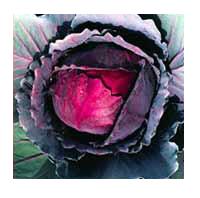No edit summary |
|||
| Line 37: | Line 37: | ||
[[Image:Cabbage 03.jpg|200px|right]] |
[[Image:Cabbage 03.jpg|200px|right]] |
||
There are at least a hundred different types of cabbage grown throughout the world, but the most common types in the United States are the Green, Red, and Savoy varieties. Chinese varieties are also available. The two most common types of Chinese cabbage are Bok Choy and Napa cabbage. Chinese cabbage cooks in less time than standard U.S. types, but can be prepared in the same ways. Cabbage can be steamed, boiled, braised, microwaved, stuffed, or [[:Category:Stir-Fry Recipes|stir-fried]]. |
There are at least a hundred different types of cabbage grown throughout the world, but the most common types in the United States are the Green, Red, and Savoy varieties. Chinese varieties are also available. The two most common types of Chinese cabbage are Bok Choy and Napa cabbage. Chinese cabbage cooks in less time than standard U.S. types, but can be prepared in the same ways. Cabbage can be steamed, boiled, braised, microwaved, stuffed, or [[:Category:Stir-Fry Recipes|stir-fried]]. |
||
| + | |||
| + | * [[:Category:Cabbage Recipes|Cabbage Recipes]] |
||
==Sources== |
==Sources== |
||
Revision as of 16:19, 3 March 2010
Cabbage, one of the oldest vegetables, continues to be a dietary staple and an inexpensive food. It is easy to grow, tolerates the cold, and keeps well. Cabbage is an excellent source of Vitamin C.
The cabbage (Brassica oleracea Capitata Group) is a plant of the Family Brassicaceae (or Cruciferae). It is herbaceous, biennial, and a dicotyledonous flowering plant with leaves forming a characteristic compact cluster. This so-called 'cabbage head' is widely consumed — raw, cooked, or preserved — in a great variety of dishes, and is thus a leaf vegetable.
The cabbage head was bred into the species from the leafy wild plant, found in the Mediterranean region around 100 AD. The English name derives from the French caboche ("head"). Varieties include red cabbage and savoy cabbage.
Besides cabbage proper, the species, Brassica oleracea has many distinctive cultivars, which are commonly known by other names: broccoli (Italica Group), cauliflower (Botrytis Group), kale, collard greens, and spring greens (Acephala Group), kohlrabi (Gongylodes Group), brussels sprouts (Gemmifera Group), Chinese kale or Chinese broccoli (Alboglabra Group), broccolini (Italica × Alboglabra Group), and broccoflower (Italica × Botrytis Group).
Chinese cabbage, while resembling cabbage, is an independent development from a different Brassica species. Kerguelen cabbage is yet another unrelated species.
Name Variations
- chinese chard
- chinese white cabbage
- chinese cabbage
- chinese mustard
- bok choy
- pak choy
- pak choi
- baak choi
- white mustard cabbage
- white celery mustard
- taisai
- bai cai
Selection
Look for solid, heavy heads of cabbage. Avoid cabbage that has discolored veins or worm damage. Do not buy precut cabbage, the leaves may have already lost their vitamin C. Look for stems that are healthy looking, closely trimmed, and are not dry or split.
Storage
Keep cabbage cold. This helps it retain its vitamin C content. Place the whole head of cabbage in a plastic bag and store in the refrigerator. Once the head has been cut, place the remainder in plastic bags and place in the refrigerator. Try to use the remaining cabbage in the next day or two.
Preparation
Do not wash cabbage until you are ready to use it. Avoid slicing or shredding cabbage in advance. This will cause it to lose some of its vitamin C content. If you must prepare it an hour or more in advance before cooking, place it in a plastic bag, seal tightly, and refrigerate.
Varieties
There are at least a hundred different types of cabbage grown throughout the world, but the most common types in the United States are the Green, Red, and Savoy varieties. Chinese varieties are also available. The two most common types of Chinese cabbage are Bok Choy and Napa cabbage. Chinese cabbage cooks in less time than standard U.S. types, but can be prepared in the same ways. Cabbage can be steamed, boiled, braised, microwaved, stuffed, or stir-fried.
Sources
- Vegetable of the Month: Cabbage by the US Centers for Disease Control & Prevention, public domain government resource—original source of article
- Cabbage on Wikipedia


